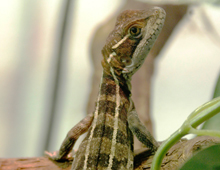Description: Striped basilisks are brown or olive brown and are dark-barred dorsally and have variably distinct yellowish lines. Their head is large and a large flap-like crest projects from the back of the head down to the neck. This crest is more prominent in males. They also have a crest that extends from above their shoulders to about the level of the hind legs. The snout is elongated. They have long, slender limbs and tails. The large hind feet have flaps of skin between the toes and specialized scales on the bottom.
Size: They reach total lengths of two feet (0.6 m), with females being smaller.
Behavior: They are agile creatures, able to hop, run swiftly, climb and swim. Adult males are very cautious and may often be heard crashing to safety through the vegetation. When startled, they are able to run over still water in an upright position (bipedal locomotion).
Diet: They feed mostly on insects but may sometimes eat fallen berries.
Communication: Head bobbing is used as a threat gesture and also during courtship.
Reproduction: Females choose a safe nest site, usually a hole along a canal, to lay anywhere from 3-12 eggs. She then covers them with soil. After laying the eggs there is no further care given and the eggs hatch in about 55 to 65 days.
Habitat/range: They are found in tropical and subtropical dry, wet and moist forests. Within their range, they are widespread and can been found wherever there is a water source. Native to Latin America and are found from Mexico south to Colombia. They have also been introduced to Florida.
Status: Not evaluated for IUCN Red List.



